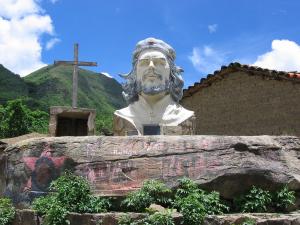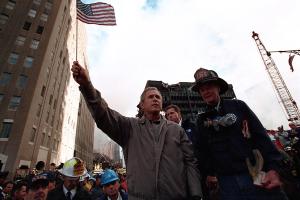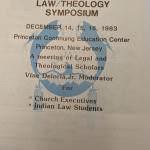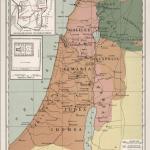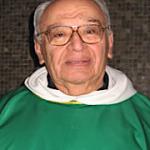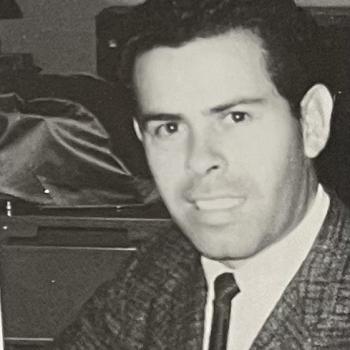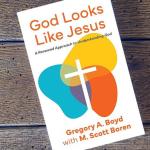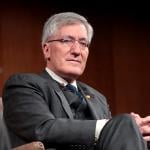This has been an active summer for me, one that I did not anticipate, and I have not even written yet about my family trip to Japan! Recently I have read some new books on Latino politics and Christianity that I would like to highlight and connect it to two events: a new paper that was published and a somewhat formative moment in my life.
First, I worked with a couple of my students on a research project this summer covering the life of Dr. Jesse Miranda. I never heard of Miranda until I started teaching at Vanguard. I had read a few short pieces about him, mostly online eulogies, but it wasn’t until this year that I became more interested in his life and ministry. I will save the details of this project for next month to open up Hispanic Heritage Month. Let’s just say you will be hearing more about him from me.
Second, an essay that I have worked on for years and presented at some past conferences was recently published. It looks at the way Argentinian revolutionary Ché Guevara was utilized as a religious/political symbol across Latin America and in the Chicano Movement. Recall that Ché had joined the Castro brothers to spark the Cuban Revolution in 1959 and was later caught and executed for attempting a guerilla war in Bolivia in 1967. He lived a short, whirlwind life and wrote one of the primers on guerilla warfare.
It is amazing how quickly Ché was seen as a sort of radical messianic figure in murals (he pops up all over the place-even telenovelas!). What is perhaps more surprising was the way some figures associated with Latin American Liberation Theology theologized from the life and words of Ché. Here was Ché seemingly putting it all on the line to helped the oppressed of Latin America. Ché’s advocacy of revolutionary violence, however, seems incompatible with the life and words of the Prince of Peace.
As George Mariscal points out in Brown-Eyed Children of the Sun, even activists and artists of the Chicano movement realized that for all the radical youthful admiration of Ché in the 1960s-70s, the nonviolent model of Cesar Chavez provided another option. A big part of Mariscal’s book is comparing and contrasting these two paths. Perhaps more theological thinking of this time would have been better served focusing on Chavez’s non-violent model instead of romanticizing Ché. It might be worth revisiting the Ché and Chavez dynamic for our current age.
This topic brings up some recent literature about Latinos and politics that I have read this year. Much Latino/Chicano literature tends to highlight student movements and the few standout leaders like Chavez. If the focus, however, seems to be mostly on student activists then you are missing the big picture. This narrow focus betrays the fact that many Latinos have been engaged in politics for decades due to their religious commitments. The bottom line is it is refreshing to see books highlight Latinos and their religious and political beliefs since they are often ignored.
My interest tends to start with the historical, and at this point, one of the key figures of this recent narrative is surprisingly George W. Bush. On the one hand, upon researching Latino Pentecostals, I should not have been surprised that many supported Republican politicians especially Ronald Reagan and George W. Bush. On the other hand, this recent work illustrates that many Latinos were given a public political platform especially by Bush that was denied them from earlier times (some might say even recent times).
Gastón Espinosa’s groundbreaking study Latino Pentecostals in America covers a lot of this material and it is well worth the read (for example, it is the best secondary source on Miranda). It is a text I will be returning to for next month’s post. Another brand new book, The Latino Century by Mike Madrid, backs up this research with a look at the overall recent trends among Latinos. Madrid points out that Latinos as a voting group are not monolithic and have oftentimes been taken for granted by both political parties-Bush, in his opinion, was one who genuinely worked hard to get the Latino vote. In fact, even the recent book focused on immigration, God’s Resistance, tends to paint the Bush administration, at least when it comes to the topic of immigration, in a fair light.
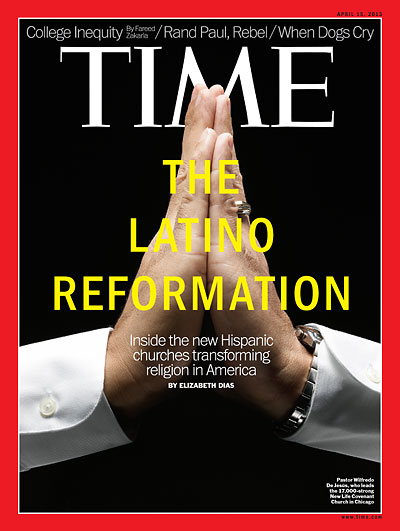
Time Magazine feature on Latino Evangelicals (2013)
Reading about Latinos and Bush takes me back to my time working in the aerospace field years before I started attending Biola University (it really seems like another lifetime). I was just coming into my own religious and political consciousness with Bush’s election. I read Bush’s A Charge to Keep and probably more importantly Marvin Olasky’s book on Compassionate Conservatism. I just started community college as a first generation Latino student and finally decided on History as my major. My first inclination was to study presidential history due somewhat to Bush (I would also abandon this course of action also probably because of Bush).
One of the big turning points in recent history is the 9/11 attacks. Like many across the world, we were all glued to our T.V. and radios while the events were unfolding and looked to President Bush for leadership. Everything seemed to stop those few weeks, shocked into disbelief by the horror of this terrorist attack.
In my youthful enthusiasm and patriotism I even made a makeshift mural of Bush from World magazine pictures to showcase my support. It is a little embarrassing reflecting on this twenty years later. The moment after 9/11 was obviously rich in religious and political symbols and my mural was just one way I could possibly think of showing support.
Bush in NY on 09/14/2001 (My birthday)
In some ways reflecting on my silly little mural has helped me to try to understand a little bit why murals are made in the first place. Christian symbolism contains a lot of influence and power especially when it mixes with politics. Pictures can inspire and comfort, giving some relief from the hustle and bustle of the present.
There are choices that are not always clear on why some people are memorialized in art. Why Ché, for example, and not some other revolutionary figure? I have not really thought much about Bush recently, it almost seems like ages ago when he was President, so it is surprising to see Latinos be the context to remind me of a simpler more optimistic time, at least in my youthful naivete and innocence. Joy and optimism are fleeting feelings in the American political world. Feelings, however, can also be manipulated. Looking back at the younger version of my collage creating self, I also feel like that is true.
For all the ups and downs of the Bush presidency, it was interesting to read about the dynamic with Latinos. I will have more to write about this when I focus on Dr. Jesse Miranda in next month’s post. What grabbed my attention about Miranda was two things. First, his commitment to his family and his faith. What also surprised me was Miranda’s involvement with these same Presidents mentioned above, both Republicans and Democrats. More on that next month.


